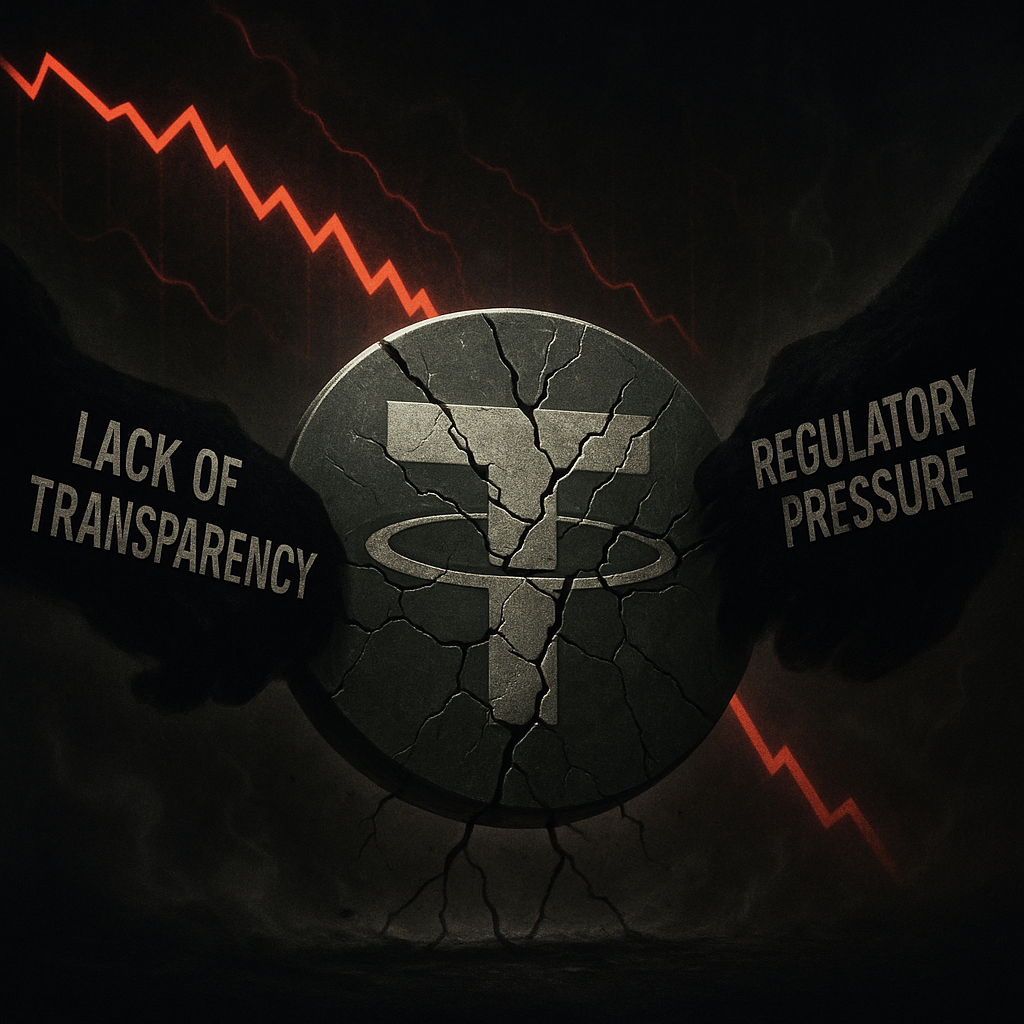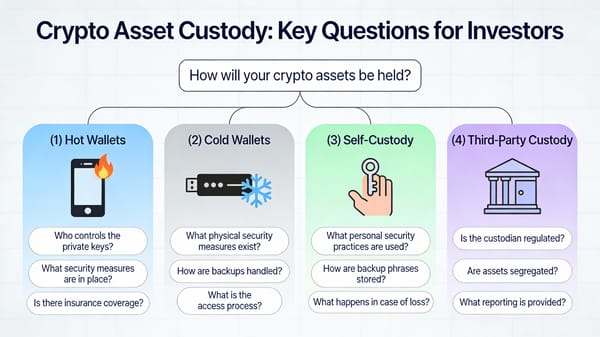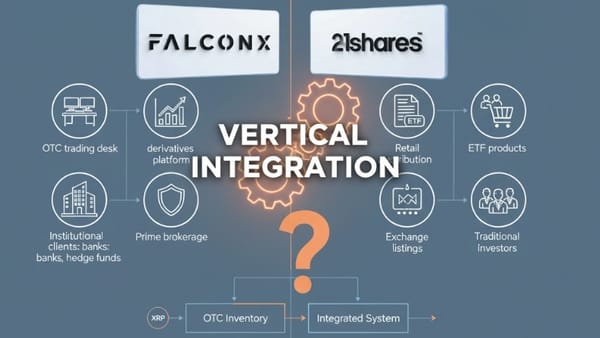The Tether Time Bomb: How USDT's Transparency Crisis Could Shake Bitcoin
Tether's 7-year audit delay and federal investigation threaten Bitcoin's stability. With USDT manipulation concerns mounting and MicroStrategy stock declining despite BTC highs, crypto's biggest systemic risk is finally getting attention it deserves.

The cryptocurrency market's $144 billion elephant in the room has a growing credibility problem that raises questions about Bitcoin's foundational infrastructure. Tether released a first-quarter 2025 attestation report showing that its reserves exceed its liabilities by $5.6 billion. Despite increased disclosure, Tether still faces criticism for lacking a full audit and unclear governance structures. With federal investigators reportedly probing potential sanctions violations, new stablecoin regulations demanding unprecedented transparency, and academic research raising manipulation concerns, questions about the stability of Bitcoin's primary trading pair are mounting—creating ripple effects already visible in MicroStrategy's puzzling stock decline despite Bitcoin's record highs.
The Audit That Never Came
For seven years, Tether has promised what it has never delivered: a comprehensive independent audit. The American consumer watchdog Consumer Warning has slammed Tether for not being transparent about its USDT reserves. The stablecoin issuer has maintained that USDT is pegged against the US dollar, redeemable at 1:1. However, the reality is more troubling than a simple delay.
Despite Tether boasting over $118 billion worth of reserves in its second quarter "independent attestations conducted by BDO," Cyber Capital's Bons claims that Tether has yet to submit its reserves for a third-party audit: "However, an 'Auditor's Report' or an 'Accountant Report' is not a formal audit at all!
The distinction matters enormously. While Tether publishes quarterly attestations from accounting firm BDO, these limited reviews fall far short of the comprehensive audits that would verify the company's claims about reserve backing. Critics question whether these attestations provide sufficient transparency for the world's largest stablecoin. Tether noted that it prepared its reserves report "using the recognition and measurement principles" of the IFRS without making sufficient disclosures to actually comply with the IFRS.
Federal Investigators Circle
The transparency concerns have attracted serious regulatory attention. Federal prosecutors in Manhattan are investigating whether Tether violated money laundering and sanctions laws through its use by global criminal networks for drug trafficking, terrorism, and hacking. The stakes couldn't be higher: The Treasury Department has been considering sanctioning Tether because of its cryptocurrency's widespread use by individuals and groups sanctioned by the US, including the terrorist group Hamas and Russian arms dealers.
This investigation isn't new—it's an escalation. On 5 December 2017, the U.S. Commodity Futures Trading Commission (prosecution) issued subpoenas to Bitfinex and Tether Limited concerning the backing of minted USD₮. The company has already paid significant penalties: In 2021, the United States Commodities and Futures Trading Commission (CFTC) fined Tether a $41 million civil monetary penalty for lying about USDT being fully backed by reserves.
The Bitcoin Manipulation Theory
Academic research has raised questions about correlations between Tether issuance and Bitcoin price movements. Research by Griffin and Shams found that bitcoin prices increased after Tether minted new USD₮ during market downturns. They speculated this could indicate an attempt at market manipulation, though Tether has contested these findings.
Multiple studies have reinforced these concerns:
- A 2021 study observed unusually high cryptocurrency returns in the 24 hours before and after stablecoin issuances
- In 2022, another study found that bitcoin prices increased following public announcements by Whale Alert on Twitter about Tether minting USDT
- Data from Whale Alert shows the relation between USDT issuance and Bitcoin price movements by plotting Tether's net minting and burning alongside the price of Bitcoin from 2015 to early 2025.
The pattern raises questions among researchers: during Bitcoin downturns, Tether mints new tokens, which are then used to purchase Bitcoin, potentially providing price support. Beginning Apr. 8th, Tether began increasing the circulating supply of USDT. Over the last month, the supply of USDT increased by $417 million. This latest minting event coincided with market volatility, reinforcing questions about the relationship between USDT issuance and market movements.
The Dollar Problem Theory
The fundamental issue extends beyond manipulation to a deeper structural problem: Tether's role as Bitcoin's primary trading pair creates dangerous dependencies. Tether is the largest cryptocurrency in terms of trading volume, holding 70% of the market share among stablecoins. In 2019, it surpassed bitcoin to become the most traded cryptocurrency globally.
This dominance means Bitcoin's price discovery mechanism relies heavily on a stablecoin that:
- Has never undergone a full audit despite seven years of promises
- Changed its backing claims from "1-to-1" dollar reserves to including "other assets"
- Faces active federal investigation for potential criminal violations
- Now confronts new regulatory requirements that could force fundamental operational changes
As stated by Strix Leviathan CEO Jesse Proudman: "Tether is worth $1 because it's generally agreed upon that it's worth $1, not because it can be redeemed for that dollar. Should that faith vanish, the repercussions would be material, widespread and volatile."
MicroStrategy's Puzzling Performance
The Tether concerns provide crucial context for understanding MicroStrategy's recent stock behavior. MicroStrategy (MSTR) stock continued its downward spiral on August 14, 2025, even as Bitcoin reached a new all-time high of $124,420. The company's shares fell to $375.80, a 20% decline from its year-to-date high of $457 and a 30% drop from its 2024 peak.
This divergence is particularly striking given MicroStrategy's role as a leveraged Bitcoin proxy. MicroStrategy holds 628,946 Bitcoins valued at over $74.78 billion, with an average cost per coin of $73,288. This results in a realized gain of 62%. Yet the stock has underperformed Bitcoin significantly.
Several factors explain this disconnect:
Valuation Concerns: The company's market capitalization of $107 billion has a NAV multiple of 1.428, which has fallen from a peak of 3.31 in November 2024. The $33 billion gap between its current market capitalization and its Bitcoin holdings suggests that the stock is overvalued.
Market Saturation: The Bitcoin treasury industry has become increasingly saturated, with over 100 companies following MicroStrategy's model to boost their stock prices. This saturation has contributed to the falling premium of the MSTR stock.
Short Interest: SeekingAlpha data shows that the short interest in MSTR has jumped to almost 10%, with prominent short-seller Jim Chanos among those betting against it.
Dilution Fears: MicroStrategy has issued more shares to buy Bitcoin, with its total outstanding shares jumping to 261 million from 78 million in 2022. While the company argues that the dilution has been justified by a 2,100% rise in share price since its 2022 low, the increased supply has diluted ownership and added downward pressure.
XRP/Ripple Analysis: The Regulatory Contrast
The Tether situation offers an interesting contrast to Ripple's legal journey. While Ripple faced years of SEC litigation over XRP's classification, Tether operates in a more complex gray area involving potential criminal violations rather than securities law.
Key Differences:
- Regulatory Clarity: Ripple's case centered on securities classification; Tether faces potential sanctions and criminal charges
- Market Position: XRP maintains its position despite legal uncertainty; USDT's role as Bitcoin's primary trading pair makes it systemically more critical
- Resolution Path: Ripple's case has clear legal precedents; Tether's situation involves multiple agencies and could result in sanctions rather than just fines
Potential Impacts on XRP:
- If Tether faces sanctions, alternative stablecoins like USDC could gain market share
- Increased scrutiny on stablecoins might benefit regulated alternatives
- XRP could potentially benefit from stablecoin market disruption if Ripple positions itself as a compliant alternative
Partnership Opportunities: Ripple's regulatory compliance focus could attract institutions seeking alternatives to Tether-dependent trading infrastructure.
Market Implications and Risk Assessment
A Tether unraveling would create cascading effects throughout crypto markets:
Immediate Impacts:
- Massive volatility in Bitcoin and other cryptocurrencies
- Liquidity crisis on exchanges heavily dependent on USDT
- Flight to alternative stablecoins like USDC
Systemic Risks:
- Tether's USDT, the world's largest stablecoin with over $144 billion in market capitalization, has become a key liquidity vehicle in crypto markets and is often viewed as a proxy for broader capital inflows.
- Potential collapse could trigger broader market contagion
- Questions about other stablecoin operators' practices
MicroStrategy Vulnerability: As the largest corporate Bitcoin holder, MicroStrategy faces unique risks. If the value of the company's bitcoin were to drop below debt levels at the time the convertible bonds matured, and the MSTR stock price was below the conversion price (which would be very likely in that scenario), Strategy — in order to prevent massive dilution in its stock — would likely decide to sell bitcoin to repay the bonds in cash rather than converting them into equity.
Regulatory Pressure Intensifies: The GENIUS and CLARITY Acts
The regulatory noose is tightening around Tether with the passage of landmark cryptocurrency legislation that could fundamentally alter the stablecoin landscape. The U.S. House of Representatives has passed stablecoin-regulating legislation known as the Guiding and Establishing National Innovation for U.S. Stablecoins (GENIUS) Act, which now gets forwarded to President Donald Trump. The bill passed 308-122 and establishes the first comprehensive regulatory guidelines for stablecoins in the US.
Stringent Requirements for Tether: The GENIUS Act establishes a clear regulatory framework for the issuance of "payment stablecoins"—digital assets backed by low-risk reserves like cash or Treasuries and designed to maintain a fixed value attached to a national currency. For Tether, which has previously faced scrutiny regarding its reserve backing and audit processes, compliance could represent a major internal overhaul.
Key Compliance Challenges:
- 100% Reserve Backing: Stablecoin issuers must hold 100% of reserves in cash, US Treasury securities, or similar securities. Stablecoins must be backed with eligible assets on a 1:1 basis. However, a recent report from JPMorgan has raised concerns that a portion of Tether's reserves, particularly its Bitcoin holdings, might not meet the stringent reserve requirements outlined in the bill.
- Mandatory Audits: The Act requires issuers with more than $50 billion in outstanding payment stablecoin issuance to obtain annual audited financial statements, which must cover related party transactions. Tether has never submitted to a full audit despite promising one for seven years.
- Monthly Transparency Reports: Permitted issuers must disclose their redemption policies, and an issuer's CEO and CFO must disclose and personally certify a monthly report on the composition of the issuer's reserve asset holdings. The permitted issuer must also hire an independent public accountant to examine each monthly report.
- Anti-Money Laundering Compliance: Payment stablecoin issuers are designated as "financial institutions" under the Bank Secrecy Act therefore subjecting them to robust anti-money laundering, customer due diligence (i.e., know your customer checks), and transaction monitoring requirements.
Foreign Issuer Restrictions: The legislation requires that foreign-issued stablecoins meet the same standards as U.S.-based counterparts, including compliance with reserve mandates, anti-money laundering regulations, and sanctions checks. Under the GENIUS Act, the Treasury Department may determine that a non-US issuer (that is not a permitted payment stablecoin issuer) of any payment stablecoins trading in the United States has failed to comply with a court order or agency action.
Tether's Response: Tether CEO Paolo Ardoino has confirmed the company's commitment to full compliance, stating "Tether will comply with the GENIUS Act." Ardoino said his company's new chief financial officer, Simon McWilliams, "started to work" to land a "Big Four" audit firm — one of the global leaders in financial auditing — which has only been a possibility because of the recent support from the Trump administration.
Market Impact Concerns: Critics warn that Can Tether survive the GENIUS Act's strict financial disclosure rules, or will it be forced to restructure its reserves, lose market share, or risk falling out of compliance? Given Tether's history of fines and violations—it is banned from New York and paid the Commodity Futures Trading Commission (CFTC) $42.5 million in fines for misleading claims about its reserves—there are serious questions about whether the company can meet these new standards.
The CLARITY Act Factor: The House also passed the Digital Asset Market Clarity Act with bipartisan support, which would create a broader framework for digital assets to be governed as commodities, securities, or stablecoins. This comprehensive approach signals that the days of regulatory uncertainty in crypto are ending, potentially forcing non-compliant players to either adapt or exit the market.
The Treasury Company Unraveling Risk
Internet speculation has increasingly focused on potential unraveling scenarios similar to what happened with SharpLink Gaming, which provides a cautionary tale for crypto treasury companies. SharpLink Gaming shares dip after $400M deal to boost Ether holdings and SharpLink rose to nearly $80 on May 29, two days after announcing that it had raised $425 million in a private investment in public equity, or PIPE, offering to establish an Ethereum treasury—a move that boosted its stock price more than 400%.
However, the volatility has been extreme: Shares in SharpLink Gaming plummeted more than 70% in post-hours trading Thursday after the company—which recently announced that it would create an Ethereum treasury—filed an S-3 shelf prospectus with the SEC to potentially sell securities.
Systemic Concerns: A new report from Galaxy Digital warns that Digital asset treasury companies may be courting disaster as their risky growth model shows signs of fragility. The report highlights that The financial structure of digital asset treasury companies relies on one crucial condition: that their stock price remains higher than the net asset value (NAV) of their holdings. As long as this equity premium exists, they can raise capital by issuing new shares, buy more crypto, and boost their NAV even further. But if this premium evaporates—or worse, flips into a discount—the model breaks down.
Historical Parallel: Galaxy compares this reflexive loop to the investment trust bubble of the 1920s, where speculative fever drove investors into highly leveraged entities like the Goldman Sachs Trading Corporation, which was essentially the MicroStrategy of its time. The bubble eventually burst with devastating consequences.
Growing Risks: Galaxy observes that "ten or so firms a week are now crowding into this trade." These digital asset treasury companies are not only pursuing the same strategy—they're highly correlated to one another and to the underlying crypto markets.
Regulatory Response: With all this mess surrounding Tether and the new GENIUS Act requirements, it's hard not to see why some would consider moving over to USDC. Its transparency and compliance seem almost tailor-made for avoiding exactly the kind of situation we're seeing play out right now with Tether. Circle's USDC already operates under more transparent models and would likely meet GENIUS Act standards with minimal adjustments, potentially positioning it to gain market share as Tether struggles with compliance.
Preparing for Potential Disruption
The convergence of Tether's transparency crisis, the new GENIUS Act regulatory requirements, Treasury Secretary Bessent's "net zero" Bitcoin acquisition strategy, and the emerging risks in crypto treasury companies creates a perfect storm of systemic vulnerability. While Bitcoin reaches new highs and companies like MicroStrategy and SharpLink Gaming attract massive capital inflows, the underlying structural weaknesses suggest the market is maturing beyond its Wild West phase.
Key Takeaways:
- Tether's transparency crisis has attracted federal criminal investigation while the new GENIUS Act demands 100% reserve backing, monthly audits, and compliance with strict AML requirements—potentially forcing the world's largest stablecoin issuer to undergo fundamental operational changes
- Academic research suggests potential Bitcoin price manipulation through USDT minting patterns during market downturns, a practice that new regulations could finally address
- Treasury Secretary Bessent's commitment to making the U.S. the "Bitcoin superpower of the world" through budget-neutral pathways signals government support for Bitcoin while demanding transparency from supporting infrastructure
- MicroStrategy's underperformance despite Bitcoin highs reflects growing market sophistication and investor wariness of leveraged crypto proxies during uncertain regulatory transitions
- SharpLink Gaming's extreme volatility demonstrates the fragility of crypto treasury company business models when regulatory or market conditions shift rapidly
- The GENIUS Act creates an existential challenge for Tether: comply with unprecedented transparency requirements or risk being shut out of the world's largest financial market
The Regulatory Reckoning: The passage of the GENIUS Act represents a watershed moment for stablecoins, creating the first comprehensive federal framework for digital dollar alternatives. Tether's CEO Paolo Ardoino has committed to compliance, but the company faces massive challenges: obtaining its first real audit after seven years of promises, restructuring reserves to meet 1:1 backing requirements, and implementing robust AML controls while maintaining its offshore structure. These changes come as Treasury Secretary Bessent's vision of America as the "Bitcoin superpower of the world" demands that supporting infrastructure meet the highest standards of transparency and regulatory compliance.
The cryptocurrency market has matured enough to recognize that past performance doesn't guarantee future stability. As institutional adoption grows and regulatory frameworks solidify, the market's tolerance for opacity, potential manipulation, and questionable business models is rapidly diminishing. The government's strategic approach—supporting Bitcoin's growth through budget-neutral accumulation while implementing strict oversight of critical infrastructure—reflects a sophisticated understanding of how to foster innovation while protecting market integrity.
Whether Tether can successfully navigate the GENIUS Act's requirements while maintaining its market dominance, whether crypto treasury companies can sustain their valuations during this regulatory transition, and whether Bitcoin can maintain its upward trajectory with more transparent and regulated trading infrastructure will define the next phase of cryptocurrency market evolution.
Investors should monitor these developments closely and consider diversifying exposure away from Tether-dependent trading infrastructure and highly leveraged crypto treasury proxies. The era of regulatory uncertainty is ending, but the transition may prove more turbulent than many expect. The next few months will be crucial in determining whether the world's largest stablecoin can adapt to the new regulatory reality or becomes a cautionary tale in cryptocurrency's ongoing institutionalization—a transformation that could ultimately strengthen Bitcoin's long-term prospects by building it on more solid, transparent foundations.
- PYMNTS.com - "Peeking Under the USDT Hood: Tether Releases Partial Audit Amid Growing Scrutiny"
- CCN - "Tether Under Fire for Lack of USDT Reserve Transparency in New Report"
- Cointelegraph - "Investors claim Tether's $118B reserves may face audit and liquidity risks"
- CoinGeek - "Tether claims record $2.85 billion profit in Q4, still can't afford an audit"
- Wikipedia - "Tether (cryptocurrency)"
- Fortune Crypto - "Tether blasts report that stablecoin giant is under investigation for money laundering, sanctions violations"
- AInvest - "MicroStrategy Stock Drops 20% Amid Bitcoin ATH, Technicals Suggest Further Downside"
- CoinDesk - "MicroStrategy's BTC Correlation and Leverage: Is MSTR Overvalued After All-Time Highs?"
- CoinCentral - "MicroStrategy (MSTR) Stock: Shares Drop 10.6% Following Bitcoin Slump"
- CryptoSlate - "Tether accused of minting almost $400 million in uncollateralized USDT to prop up bitcoin"
- CoinDesk - "GENIUS Act for Stablecoins Passes House on Way to be First Major U.S. Crypto Law"
- The Block - "US Treasury Secretary Bessent says government won't buy bitcoin for strategic reserve"
- Cointelegraph - "SharpLink Gaming shares dip after $400M deal to boost Ether holdings"
- Galaxy Digital - "Digital Asset Treasury Companies Face Growing Risks"
- WilmerHale - "What the GENIUS Act Means for Payment Stablecoin Issuers, Banks, and Custodians"
DISCLAIMER: This newsletter is for informational purposes only and does not constitute investment advice or a recommendation to buy, sell, or hold any securities. Investments in cryptocurrencies or other financial assets carry significant risks, including the potential for total loss, extreme volatility, and regulatory uncertainty. Past performance is not indicative of future results. Always consult a qualified financial professional and conduct thorough research before making any investment decisions.



